The Green-winged Teal (known as Common Teal in English-speaking parts of Eurasia) is currently considered a single species by the AOU, but two subspecies are distinctive in adult male plumage and are split into two species by many authorities.
- Green-winged Teal (American) – Anas crecca carolinensis
- Common Teal (Eurasian) – Anas crecca crecca ((Common Teal nests in the Aleutian Islands, Alaska, and birds there and in Siberia average larger than those in Europe (which are the same size as American Green-winged Teal). Therefore, Common Teal on the Pacific coast, which presumably come from Siberia, often look slightly larger than their Green-winged flock-mates. These larger birds were formerly separated as the subspecies A. c. nimia, but variation is broadly clinal and that subspecies is no longer recognized.))
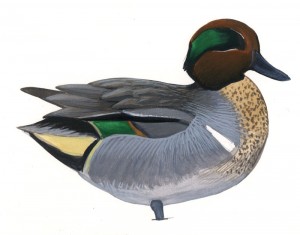
Common Teal is a rare visitor to North America, occurring in small numbers each winter along both coasts but most frequent in the north and much less frequent in the far south. It is extremely rare inland. Records are strongly clustered in spring (March-April) but this presumably reflects the fact that males in eclipse (non-breeding) plumage are essentially unidentifiable in the fall, and are difficult to pick out of the large flocks on the wintering grounds. They are found as they make their way north (now in full breeding plumage) with relatively small numbers of teal moving along the coast.
The most conspicuous difference in males is the presence of a horizontal white stripe along the lower scapulars on Common Teal (absent on Green-winged) and the presence of a vertical white bar on the side of the breast of Green-winged (absent on Common). There are other small differences outlined below, but most or all of these are variable and seem less reliable… or maybe the white stripe just seems reliable because that’s how we define a Common Teal (more on that below).
Understanding Feathers
First, it’s critical to understand the feathers that are involved, and how the arrangement of feathers affects the appearance of the field marks. Here is a Green-winged Teal with feathers fluffed to show the arrangement.
The flanks are gray with fine barring, but it’s impossible to make out individual feathers. These flank feathers can be moved up or down (see below) to overlap more or less of the wing. Just above the flanks we can see a little of the bird’s wing – from front to back the darker gray coverts on the leading edge of the wing, a band of cinnamon formed by the tips of the greater coverts, the iridescent green of the secondaries, and white tips on the secondaries. On the bird’s back the brownish-gray feathers are the scapulars, which are relatively long and easy to pick out as individual feathers. Behind the scapulars the longer feathers the same color are the tertials. Finally, just below the scapulars is a band of gray feathers (I’ve enhanced the contrast to make them more obvious here). These are the feathers we need to focus on. ((I’ve realized as I paint that I don’t know what these feathers are. They seem to be separate from the scapulars, not just a row of lower scapulars… but that’s another research project for another post.))
Identifying the subspecies
On this Green-winged Teal these “lower scapulars” are gray with a very narrow and inconspicuous white edge and black lower border. On Common Teal these feathers are clean white with a black lower border. The broader white stripe on Common Teal continues rearwards onto the lowest tertial. That’s it. Because these “lower scapular” feathers can be overlapped by the flanks (from below) or the scapulars (from above) depending on the bird’s mood, the white stripe of Common Teal can be obvious or nearly absent.
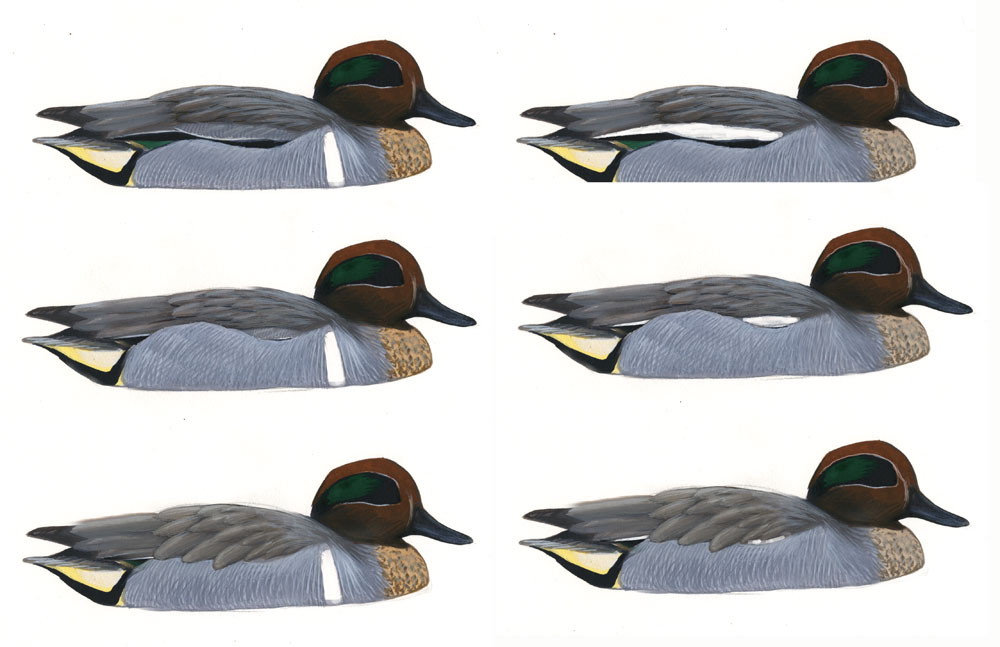
Besides the obvious white stripes, other differences between these subspecies are listed here, but only the first two on the list seem to be obvious and consistent enough to be useful. The others are merely tendencies and only suggestive of identification.
- white lines on face more complete and more conspicuous on Common
- breast paler and grayish, less buffy, on Common
- head paler red-brown on Common
- tertials more contrastingly marked on Common
- flanks paler overall with coarser barring on Common
- pale band between black undertail coverts and gray flanks broader and paler
- Iridescence of eye stripe may be sometimes more blue-purple on Common (vs green on Green-winged)
Intergradation
These two subspecies interbreed freely where their ranges overlap, but their ranges barely overlap, so intergrades are rare. Intergrades are probably about as frequent as pure male Commons in North America, or maybe a little more frequent, but tend to be overlooked or simply not reported.
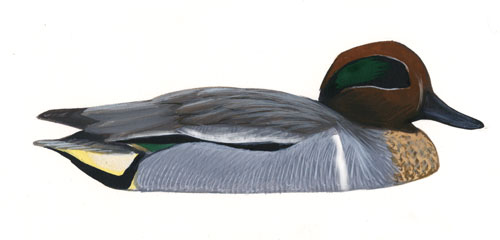
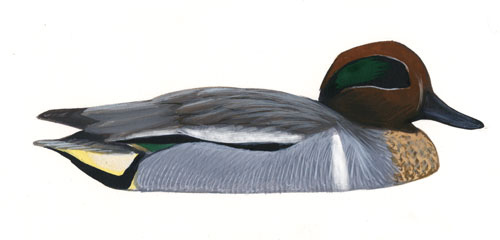
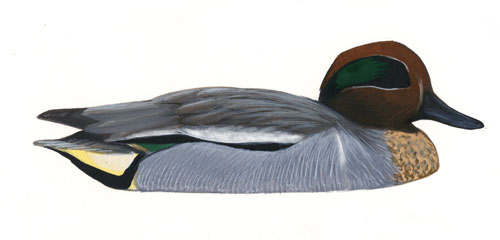
Intergrades can show various combinations of features. Many look intermediate in both of the parental white stripes as shown above, but others can express one white stripe fully while showing only a hint of the other. I have seen a few individual teal showing neither of the white stripes and these might be intergrades as well. Among the other features described above (head pattern, etc) the differences are subtle, and it can be impossible to judge intermediacy, but intergrades usually seem to show a mixture of features typical of both parents rather than intermediate features.
One male in Concord, Massachusetts on 25 Mar 2011 showed the full white stripe of Common, with no trace of the white bar of Green-winged, and also showed obvious white lines on the face and a grayish breast. But it’s head was conspicuously darker than any of the 50 or so Green-wingeds present, and it showed blue/purple iridescence behind the eye (not typical of either subspecies). Was this actually an intergrade that just happened to show a Common-like white pattern?
A small but significant percentage of Green-winged Teal show a reduced white vertical bar on the breast-sides (shown below, perhaps 10%, depending on how “reduced” is defined). This is probably too frequent to be attributed to intergradation, but an individual that also shows slightly increased white on the scapulars, or another feature tending towards Common Teal, might be suspect.
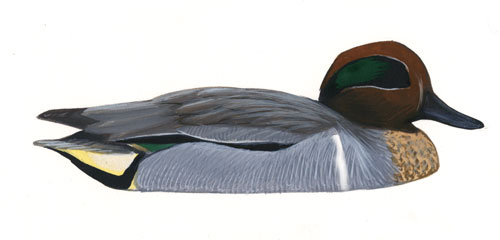
By using a single plumage feature (white stripes) to define the subspecies and intermediates, we are merely taking the easy route to categorizing them. The true ancestry of these birds may be impossible to determine by plumage, but we should take care to study all the plumage features and try to get a better understanding of variation.
References
Gillson, G. 2004. Common Teal: Eurasian and American Green-winged Teal and hybrids: an identification challenge. http://thebirdguide.com/identification/Eurasian_Teal/teal_hybrid.htm – A detailed discussion of intergrades in Oregon, with photos.


I just moved to St. John’s NL this past winter and there have been a surprising number of Common Teal around. From what I have been told this species is annual here, but this year had been a particularly good one….on numerous occasions up to 25 birds have been seen at once, sometimes more. In fact, it is quite a task to turn up a Green-winged Teal!
Before I moved to NL, I had only seen this species a few times before in Alaska, but it seems to me that the Common Teal are almost always associated with marshier habitat than Green-wings. Most of the Common Teal around St. John’s as well as the ones I have seen elsewhere seem to prefer areas with particularly low water and large grass/sedge mats (where they almost always associate with American and Eurasian Wigeon) whereas the Green-wings are usually on slightly more open ponds or lakes and seem to also like estuarine areas.
Having said that, I have often seen Green-wings in marshy fields and at least a few Commons on salt water in fairly open estuaries, but I wonder if the differences between these two subspecies or species extend as far as a subtle difference in diet or habitat preference?
I would guess not. As someone from England, I can assure that (common) teal are found in virtually any wet meadow, pond, lake, or estuary habitat, and frequently. They certainly prefer shallower ponds though — but in my experience, so does green-winged teal.
Interesting! When I’ve seen Common Teal – along the Atlantic coast of the US, also in California, and Alaska – they have always been with groups of Green-winged Teal and I’ve never noticed any difference in habitat or behavior. I’ll be interested to hear from others on this.
To follow up on my earlier post, it seems like most of the Green-winged ARE in the company of larger flocks of Common around town, but when I have seen groups of Common on their own, they always seem to be in very grassy/marshy areas, and when I have seen single or small groups of Green-winged on their own, they seem to be in more open habitat with deeper water. Of course this is more of a poorly-defined pattern than a hard and fast rule, and I too would be very interested to hear other opinions.
Also, it seems like the Green-winged are the ‘hangers-on’ when they join up with the Commons. Case in point: a recent post from Bruce Mactavish on the local birding forum reports 13 Common and a single Green-winged from the marshiest area of a large pond in town, with the interesting comment that while the Common were quite vocal, the lone Green-winged remained mostly silent. I too have been watching this same flock frequently over the last month or so, and it certainly does seem that the Green-wing(s) are always on the periphery of the typically tight group of Commons. It’ll be really cool to see what differences there might be in the courtship behaviour of these two subspecies, particularly if the males seem to ignore the “wrong” females.
-MM
Greetings
On Adak Island during the last week of May, Bill Tweit and I (and a couple others) saw several Common Teal with no white bar at all. These birds were observed for a period of time, and I’ve got shots of one in flight, so I don’t think the white stripe was hidden, though possible I guess. Interestingly, these birds otherwise looked absolutely like Common Teal, include being huge (as Aleut Common Teal are; the one Am GW Teal that showed up really looked dinky… Also of note, the Common Teal in Washington State often DO NOT look larger than GW Teal, which makes me wonder where they come from). On the other hand, in Washington State during winter, we rarely will see a teal without either white bar, and those DO look like hybrids (unlike the Adak birds), with intermediate head markings, and others, as so nicely delineated by David above.
Steven Mlodinow
Hi David,
I figured I would post this given the recent thread on ID-Frontiers with link to your great article.
This afternoon in Connecticut I observed, from a bit of a distance, what I would call an intergrade Green-winged Teal. Some poor digiscoped photos with notes can be viewed here:
http://www.shorebirder.com/2012/03/probable-intergrade-green-winged-teal.html
Nick
Today we saw a teal in amongst a flock of green-winged teal, one that looked very similar but had a distinctive purplish eye stripe. Is this the Common Teal? Location: Blenkinsop Lake , Victoria, Vancouver Island,.
Color of the iridescence on the eye patch seems to vary in both forms, usually mostly green but it can be purple to blue. This is probably just a rare variant that shows up in both subspecies.
I had a local Green-winged Teal on a pond when I lived up in Alberta, Canada which had a complete purplish eye stripe.
Adding to Steve Mlodinow’s comment, I saw five male teal at Dutch Harbor, Unalaska on July 18, 2007 that were undergoing molt out of breeding plumage, but on the three that were still essentially in breeding plumage they lacked any white horizontal scap line or vertical shoulder bar:
http://ebird.org/ebird/view/checklist?subID=S22608717
We’ve had about 20 male Eurasians here in NS, fewer than St. John’s, NL, but respectable enough. However, we may have documented (photos) more hybrids/intergrades. To me, the serious i.d. issue is distinguishing females. There are a few hints in the literature, but no good survey. David: worth doing?
Pingback: Teal And Green Wedding Cake Promo Code 2018 – ecca